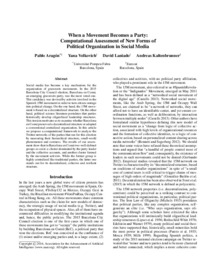Benvinguts al Repositori Digital de la UPF
When a movement becomes a party: computational assessment of new forms of political organization in social media
JavaScript is disabled for your browser. Some features of this site may not work without it.
Mostra el registre parcial de l'element
| dc.contributor.author | Aragón, Pablo |
| dc.contributor.author | Volkovich, Yana |
| dc.contributor.author | Laniado, David |
| dc.contributor.author | Kaltenbrunner, Andreas |
| dc.date.accessioned | 2017-10-05T16:27:00Z |
| dc.date.available | 2017-10-05T16:27:00Z |
| dc.date.issued | 2016 |
| dc.identifier.citation | Aragón P, Volkovich Y, Laniado D, Kaltenbrunner A. When a movement becomes a party: computational assessment of new forms of political organization in social media. In: Proceedings of the Tenth International AAAI Conference on web and social media (ICWSM 2016); 2016 May 18-20; Cologne, Germany. Palo Alto: AAAI Press; 2016. p. 12-21. |
| dc.identifier.uri | http://hdl.handle.net/10230/32866 |
| dc.description | Comunicació presentada a: The Tenth International AAAI Conference on web and social media (ICWSM 2016), celebrat del 18 al 20 de maig de 2016 a Colònia, Alemanya. |
| dc.description.abstract | Social media has become a key mechanism for the organization of grassroots movements. In the 2015 Barcelona City Council election, Barcelona en Com´u, an emerging grassroots party, was the most voted one. This candidacy was devised by activists involved in the Spanish 15M movement in order to turn citizen outrage into political change. On the one hand, the 15M movement is based on a decentralized structure. On the other hand, political science literature postulates that parties historically develop oligarchical leadership structures. This tension motivates us to examine whether Barcelona en Com´u preserved a decentralized structure or adopted a conventional centralized organization. In this article we propose a computational framework to analyze the Twitter networks of the parties that ran for this election by measuring their hierarchical structure, small-world phenomenon and coreness. The results of our assessment show that in Barcelona en Com´u two well-defined groups co-exist: a cluster dominated by the party leader and the collective accounts, and another cluster formed by the movement activists. While the former group is highly centralized like traditional parties, the latter one stands out for its decentralized, cohesive and resilient structure. |
| dc.description.sponsorship | This work is supported by the EU project D-CENT (FP7 CAPS 610349). We would like to thank DatAnalysis15M Research Network and the #GlobalRevExp Forum for their valuable discussions and suggestions that helped to improve this study. Yana Volkovich is supported by the People Programme (Marie Curie Actions, from the FP7/2007-2013) under grant agreement no.600388 managed by REA and ACC1O´ . |
| dc.format.mimetype | application/pdf |
| dc.language.iso | eng |
| dc.publisher | Association for the Advancement of Artificial Intelligence (AAAI) |
| dc.relation.ispartof | Proceedings of the Tenth International AAAI Conference on web and social media (ICWSM 2016); 2016 May 18-20; Cologne, Germany. Palo Alto: AAAI Press; 2016. p. 12-21. |
| dc.rights | © 2016, Association for the Advancement of Artificial Intelligence (www.aaai.org) |
| dc.subject.other | Mitjans de comunicació social |
| dc.subject.other | Partits polítics |
| dc.title | When a movement becomes a party: computational assessment of new forms of political organization in social media |
| dc.type | info:eu-repo/semantics/conferenceObject |
| dc.relation.projectID | info:eu-repo/grantAgreement/EC/FP7/610349 |
| dc.relation.projectID | info:eu-repo/grantAgreement/EC/FP7/600388 |
| dc.rights.accessRights | info:eu-repo/semantics/openAccess |
| dc.type.version | info:eu-repo/semantics/acceptedVersion |


